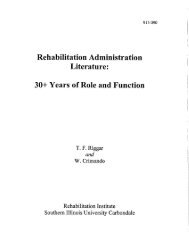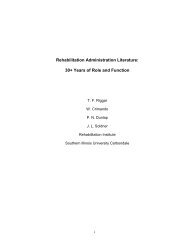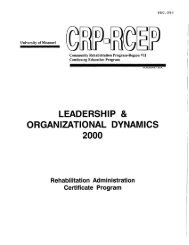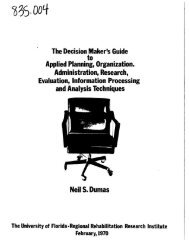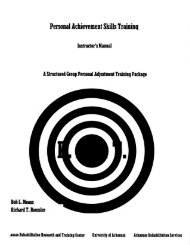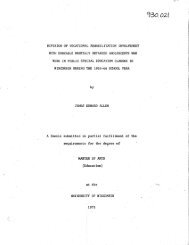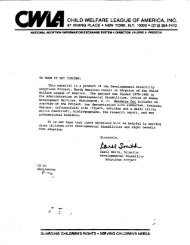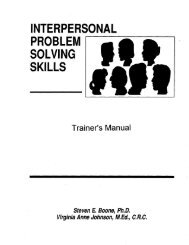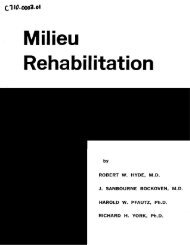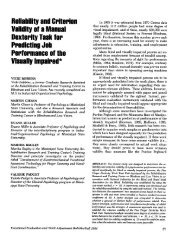Meeting Global Deaf Peers, Visiting Ideal Deaf Places ... - NCRTM
Meeting Global Deaf Peers, Visiting Ideal Deaf Places ... - NCRTM
Meeting Global Deaf Peers, Visiting Ideal Deaf Places ... - NCRTM
You also want an ePaper? Increase the reach of your titles
YUMPU automatically turns print PDFs into web optimized ePapers that Google loves.
DEAF WAYS OF EDUCATION LEADING TO EMPOWERMENT<br />
stories, marking the changes global<br />
deaf encounters brought to their<br />
lives. The sleeping metaphor refers to<br />
the oppression deaf people experienced<br />
during oralism and the absence<br />
of deaf cultural rhetoric. To understand<br />
the standard hearing view that<br />
Flemish deaf people had internalized<br />
(Freire, 2005; Jankowski, 1997), I will<br />
illustrate how oralism controlled the<br />
information provided to the deaf<br />
community in both deaf schools and<br />
deaf clubs.<br />
As Filip Verstraete (translated interview,<br />
2003), a Flemish deaf leader, explained,<br />
there was no deaf cultural<br />
rhetoric transmitted in deaf families:<br />
Yes, my parents are deaf and when I<br />
was a kid, nothing was ever said about<br />
what it meant to be deaf, about who<br />
you are as a deaf person, a deaf identity,<br />
deaf awareness. Really nothing;<br />
that was not discussed at all, never. I<br />
knew deafness that is a disability, that<br />
is the way it is.<br />
Ronny Van Landuyt (translated interview,<br />
2004), who joined the Gallaudet<br />
trip, reflected upon the absence of<br />
deaf cultural rhetoric in deaf clubs and<br />
deaf schools before:<br />
When we were 12 years old, we went<br />
to high school. In high school, the<br />
school level was higher; that was<br />
good. In the dormitory, we had a<br />
priest. He organized well, priest X,<br />
who passed away. Things were better;<br />
there were a couple of teachers who<br />
used signs. There were two teachers<br />
who really signed enough; the others<br />
were oral. But it was not the case that<br />
we broadened our horizons about<br />
“deaf,” no, nothing. It was always the<br />
same: lesson, lesson, lesson. Speech<br />
exercises, language exercises, math<br />
exercises. Narrow minded. Nothing<br />
about history, nothing about the<br />
10<br />
world, nothing about interesting<br />
things. . . .<br />
When I finally went to the deaf<br />
club, it was not interesting. It was always<br />
soccer, soccer. Really for hours.<br />
Now I can say that was bullshit, but<br />
before I didn’t realize that. For me,<br />
that was not interesting. It was just<br />
about one theme; other topics were<br />
not discussed.<br />
The individuals I interviewed for my<br />
research all talked about times after<br />
the 1960s, when indeed all deaf cultural<br />
rhetoric, deaf history, and community<br />
knowledge seemed to be gone.<br />
Nonetheless, there has always been a<br />
small group of people to whom deafhood<br />
is transmitted (Ladd, 2003). A<br />
small group of deaf people has always<br />
played a role in the Federation of the<br />
<strong>Deaf</strong> (although it was established and<br />
dominated by clergy), and in the 1970s<br />
there was a group of deaf people who<br />
wanted to set up a federation run by<br />
deaf people themselves (Scheiris &<br />
Raemdonck, in press). Yet apart from<br />
this small group, the majority of deaf<br />
people were left in the dark. Any alternative<br />
discourse that perceived deaf<br />
people as an ethnolinguistic minority<br />
rather than a group of disabled people<br />
was blocked.<br />
In the interviews, research participants<br />
explained how they provided<br />
deaf friends with information gathered<br />
in their own deaf families and from<br />
mainstream news media. They strongly<br />
reacted against teachers in schools for<br />
the deaf who were not able to communicate<br />
with deaf students who depended<br />
on sign language. <strong>Deaf</strong> people<br />
were also blocked from gathering general<br />
background knowledge about the<br />
world. Flemish deaf people refer to<br />
this stage, which is marked by fixed<br />
(medical) identities (Braidotti, 1998)<br />
and the absence of deaf cultural rhetoric,<br />
as sleeping.<br />
<strong>Deaf</strong> Cultural Rhetoric and<br />
<strong>Ideal</strong> <strong>Deaf</strong> <strong>Places</strong><br />
The rhetoric of deaf people perceiving<br />
themselves as an ethnolinguistic<br />
minority group was presented to the<br />
world for the first time in the Gallaudet<br />
revolution in 1988 (Jankowski,<br />
1997). Jankowski explains that three<br />
important rhetorics can be identified<br />
that have been empowering for deaf<br />
people in the United States. First,<br />
there is the rhetoric of sign language<br />
as a formal language, supported by a<br />
sign language dictionary and sign language<br />
research in the 1960s and<br />
1970s. Second, there is the rhetoric of<br />
deaf culture, which allowed deaf people<br />
to perceive mainstreaming and inclusion<br />
as cultural genocide and to<br />
defy the label of disabled. The rhetoric<br />
of the deaf community as an ethnolinguistic<br />
minority opened the doors<br />
for the empowering third rhetoric:<br />
the can-do rhetoric. This rhetoric of<br />
equality liberated deaf people from<br />
the rhetoric of hearing paternalism<br />
and from their internalized oppression.<br />
<strong>Deaf</strong> people are now proud to<br />
be deaf, and can decide about their<br />
own lives. The latter stage can be illustrated<br />
by I. King Jordan’s famous and<br />
empowering statement, “<strong>Deaf</strong> people<br />
can do anything that hearing people<br />
can except hear” (Christiansen &<br />
Barnartt, 1995, p. 164).<br />
Making comparisons to the rhetoric<br />
that was empowering for deaf people<br />
in the United States brings the<br />
parallels with deaf cultural rhetoric in<br />
Denmark and Flanders to the fore.<br />
The rhetoric of deaf people as an ethnolinguistic<br />
minority group, which<br />
can be proud of itself, which believes<br />
in its ability, equality, and independence,<br />
and which actively advocates for<br />
better deaf lives, seems to be empowering<br />
for deaf people in different localities<br />
in the world (De Clerck, 2005;<br />
Widell, 2000). Regarding his trip to<br />
VOLUME 152, NO. 1, 2007 AMERICAN ANNALS OF THE DEAF




